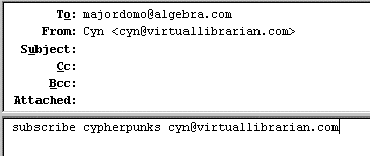

|
Finding a mailing list that appeals to you is as simple as searching through a Mailing List Directory. Search for a topic that interests you through the various directories listed below. Once you have found an interesting topic, follow the specific instructions to join the list. Joining a mailing list is similar to subscribing to a magazine subscription. You send your subscription information to an automated responder (similar to mailing your address to the processing office). Once your information or "subscribe" message is received, the responder will reply with a Welcome message. The subscription message you send should look similar to the one below. |
 Your address may start with majordomo, listproc, listserv, or mailbase, depending on the software used by the server.
Your address may start with majordomo, listproc, listserv, or mailbase, depending on the software used by the server. < --- The placements will stay the same, but the names of the group and the e'mail addresses will change. |
Do not send or unsubscribe messages to the entire group! Always save the original Welcome message because it includes the instructions. |
|
|
Sample Welcome/FAQ message |
|
|
Types of Lists |
|
Don't be surprised if you do not receive any posts (e-mails) for a while. Some groups become active for short periods of time, and then become very quite. |
| Further Information |
|
WebNovice Online - http://www.webnovice.com/mailing_lists.htm Liszt Introduction to New Mailing Lists Users - http://www.liszt.com/intro.html The Reporter's Guide to Internet Mailing Lists - http://www.daily.umn.edu/~broeker/guide.html
|
The Site |
The Bottom Line |
|
CataList, the Catalog of Listserv Lists
www.lsoft.com/lists/listref.html |
A searchable list of more than 10,000 servers worldwide, all running on L-Soft's Listserv software. Country-specific sites and lists with more than 10,000 subscribers are useful filters. Search for a list based on topic, host site, host country, and number of subscribers. |
|
Liszt Directory of E-Mail Discussion Groups
www.liszt.com |
Hands down, the most comprehensive list of lists on the Net. Choose from over 2,100 selected mailing lists in 15 categories, or search the entire database of more than 67,000 entries. Liszt includes a handy Yahoo-like index, dubbed Liszt Select. Great FAQ, too. |
|
Netscape In-Box Direct
form.netscape.com |
Choose from dozens of e-mail-based newsletters, including offers from the New York Times, the San Jose Mercury News, and ZDNet's incomparable AnchorDesk. In-Box Direct content is more than simple HTML and includes graphics, video, audio, Java applets, and live hyperlinks--all of which work from your e-mail in-box. Cool. |
|
Publicly Accessible Mailing Lists
www.neosoft.com/internet/paml |
Updated monthly and oriented toward Usenet resources, this collection contains nearly 2,000 entries, searchable by subject or in an A-to-Z list. Also available via FTP at rtfm.mit.edu. If you're searching for a university- sponsored or related list, there's a good chance you'll find it here. |
|
Yahoo's List of Mailing Lists
www.yahoo.com/ |
Continually updated links to mailing-list resources, including FAQs, lists of lists, and software vendors. Caution: Many of the links are outdated or not of general interest, but if you haven't had much luck using the other resources listed here, you might find it using Yahoo's service. |
* PC Computing Magazine (311, April 1997) or http://www.zdnet.com/pccomp/interdot/interapr/listlist.html | |
Created and Copyrighted © by Cynthia Hetherington, MLS
Sunday, August 16, 1998
Thursday, December 10, 1998 updated